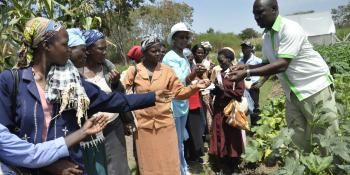Women farmers key to food security in Africa

Last week was International Women’s Day. Dr. Mary Nyasimi, a Gender and Policy Specialist with the CCAFS East Africa program, shares some insights on progress made and the way forward.
The theme for 2014 International Women's Day (IWD) was Inspiring Change. Since its inception in 1910, the event has recognized the economic, political and social achievements of women. These achievements are however quite limited, especially in the agriculture sector, due to a rapidly changing climate. The most affected is the rural woman who provides the largest labor force in agriculture, the greatest Gross Domestic Product (GDP) contributor, for most African countries.
If you want to know more about research on closing the gender gap in farming under climate change:
- read our special blog series on Closing the gender gap
- watch the presentations and the panel discussion from the Closing the gender gap event
- follow the #AgGenderGap event hashtag on twitter
Women make up a large number of the rural poor in East Africa and are exclusively dependent on local natural resources for their livelihood. They are therefore extremely vulnerable to and negatively affected by climate related risks such as droughts, unpredicted rainfall and floods.
Gender mainstreaming by African governments
East Africa governments are already mainstreaming gender into their climate change efforts at the national level. These countries have developed and are in the process of implementing National Adaptation Plans of Actions (NAPAs) in various sectors, including agriculture. Established in the Cancun Adaptation Framework by the United Nations Framework Convention on Climate Change (UNFCCC), the National Adaptation Planning (NAP) process is supposed to help facilitate effective medium and long-term adaptation planning and implementation in developing countries, and in particular Least Developed Countries (LDCs).
Read more: New report highlights lessons from National Adaptation Planning
The East Africa countries (Uganda, Tanzania and Ethiopia) have developed their NAPAs and submitted to UNFCCC. The three countries have identified adaptation priority actions that can be funded from the Least Developed Country Fund. Kenya is not listed as an LDC and is therefore not required to submit a NAPA. Therefore, Kenya has incorporated climate change adaptation strategies in its National Climate Change Response Strategy (NCCRS) with an accompanying National Climate Change Action Plan.
Read more: Climate action in Kenya: New national plan launched
However, having the NAPs/NAPAs in place is not enough for East Africa governments. What is required is bold gender sensitive policies and targeted Climate-Smart Agriculture (CSA) investments to enable women transform their agriculture from subsistence to market oriented, while actively involved in the whole value chain. If women had access to resources such as land, new agricultural knowledge, inputs and ability to make decisions on what to grow, when and how, on - farm yields could increase by 20-30 %. This extra output could reduce the number of hungry people in the world by 12-17 %.
Get these and more facts on climate change impacts on people: Big Facts

In drought prone countries, children under five are up to 50 % more likely to be malnourished if born during a drought.Photo: s.kilungu (ccafs)
With a changing climate and an increasingly vulnerable agriculture, equality among women and men particularly in access to resources (physical, human, financial) is vital. This will enable them not only improve their lives and that of their families, but also to undertake long-term adaptation to climate change.
Push for gender sensitive Climate Smart Agriculture Practices
The resilience of women to climate change should not only be measured by the current adaptive strategies they are using but the extent to which their actions will impact on future generations to come. The impacts of climate change are being felt by women and children the most. In drought prone countries, children under five are up to 50 % more likely to be malnourished if born during a drought.
What sort of impetus do East Africa governments need to transform agricultural production? The answer lies with our policy makers who should remove constrictive legislative and social-cultural factors that prevent women from accessing climate smart practices, technologies and innovations, climate information and services and micro-finance. In addition, the NAPs should integrate gender considerations in assessing vulnerability, impacts and risks to climate change at the local and national levels. Furthermore, women should be involved in climate change monitoring, adaptation and decision-making processes. By so doing, governments can have a food secure society that is climate smart, inclusive and resilient.
Read more stories on gender and women in agriculture:
Gender: from latecomer to shaping a new research agenda for agriculture and climate change
Gender-dimensions of climate-smart agriculture: what do we really know?
Empowering women to take the lead on climate change adaptation
Mary Nyasimi is a gender and policy specialist at CCAFS. Views represented in this article are those of the author and do not necessarily reflect those of CCAFS.
This story is part of a blog-series aimed to highlight International Women's Day on 8 March and this year's theme #Inspiring Change. Help us celebrate IWD by following us online on Twitter, Facebook and Storify using #IWD2014 for more updates. Read additional gender-related stories on our blog.



